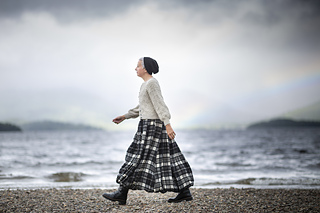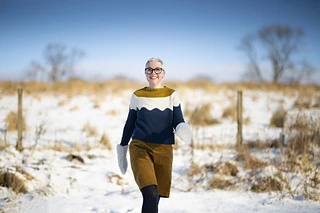patterns >  Kate Davies Designs
Kate Davies Designs
> YOLK















YOLK
A kit to knit this sweater is available from the KDD shop
Read about the development of this design
YOLK
A bold colour-blocked punning pullover, with a fried egg inspired yoke (or yolk).
Yarn
Kate Davies Designs Schiehallion (100% wool: 70% Corriedale, 30% Cheviot; 110m/120yds per 50g skein)
A Faded Overalls: 6 (6, 7, 8, 9, 10, 11, 11) x 50g skeins
B Crowdie: 2 (2, 2, 3, 3, 3, 3, 3) x 50g skeins
C Daunder: 1 (1, 1, 1, 1, 1, 2, 2) x 50g skeins
Needles and Notions
Gauge-size and below gauge-size circular needles of appropriate lengths for working body, yoke, and neckline
Gauge-size and below gauge-size needle(s) of your preferred type for working small circumferences
Stitch markers of two types
Waste yarn for holding stitches
Tapestry needle
Gauge
22 sts and 30 rounds to 10cm / 4in over colourwork pattern and stockinette in the round using gauge-size needle. If your gauge tends to tighten when working small circumferences or colourwork, you may need to go up a needle size for sleeves. Use 4mm needle as a starting point for swatching.
Sizes
Finished bust circumference: 81.5 (91.5, 101.5, 112, 122, 132, 142, 152.5) cm / 32 (36, 40, 44, 48, 52, 56, 60) in
Shown in the second size, with 5 inches of positive ease
Pattern notes
This bold colour-blocked, fried egg themed pullover is knitted from the bottom up, all in one piece. The body is made first, with the egg white pattern being worked from a chart before setting the underarm stitches aside. The sleeves are worked next, with the egg white motif worked around the sleeve tops, before body and sleeves are joined together. The yoke / yolk is worked in plain stockinette and shaped with a combination of raglan and circular yoke decreases. Turned rib completes the neckline. Charts are read from right to left throughout.

622 projects
stashed
840 times
- First published: February 2021
- Page created: February 19, 2021
- Last updated: August 28, 2024 …
- visits in the last 24 hours
- visitors right now




